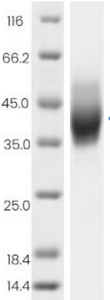Human CD326 Protein, His Tag, Avi Tag
-
产品编号
KMP2272
-
别名
上皮细胞粘附分子, Epithelial Cell Adhesion Molecule, CD326
-
规格
- 50ug
- 100ug
- 200ug
| Catalog Number | KMP2272 |
| Alias | 上皮细胞粘附分子, Epithelial Cell Adhesion Molecule, CD326 |
| Size | 50ug, 100ug, 200ug |
| Product Description | The Human CD326 Protein(KMP2272) is produced in HEK293 Cells and the target gene encoding Gln24-Lys265 is expressed with a 6His, Avi tag at the C-terminus. |
| Molecular Name | CD326 |
| Product Introduction | CD326(EpCAM):上皮细胞黏附分子,以跨膜形式参与细胞间相互作用和组织结构维持。 |
| Molecular Weight | 28.25 kDa |
| Expression System | HEK293 Cells |
| Species | Human |
| Purity | >95% |
| SDS-PAGE |  |
| Purification | Affinity Purification |
| Uniprot ID | P16422 |
| Storage Condition | Aliquot and store at -20℃ to -80℃. Avoid repeated freezing and thawing cycles. |
| Formulation | 20mM PB, 150mM NaCl, pH7.2 |
| Shipping Condition | In general, the proteins are provided as lyophilized powder which are shipped at ambient temperature. They are shipped out in dry ice if supplied in liquid form. |
| Background | Epithelial Cell Adhesion Molecule(EpCAM) is a signal type I transmembrane glycoprotein that belongs to the EPCAM family. EpCAM is composed of an extracellular domain with one thyroglobulin type-1 domain, a transmembrane domain and a cytoplasmic domain. EpCAM is found on the surface of adenocarcinoma, but not on mesodermal or neural cell membranes. The EpCAM molecule has been shown to function as a homophilic Ca2+ independent adhesion molecule. It may act as a physical homophilic interaction molecule between intestinal epithelial cells(IECs) and intraepithelial lymphocytes(IELs) at the mucosal epithelium as an immunological barrier providing the first line of defense against infection. Defects in EPCAM are a cause of hereditary non-polyposis colorectal cancer type 8(HNPCC8) and diarrhea type 5(DIAR5). EpCAM plays a role in embryonic stem cells proliferation and differentiation; it up-regulates the expression of FABP5, MYC and Cyclin A and Cyclin E. It is highly and selectively expressed by undifferentiated embryonic stem cells. |
| Endotoxin | <1.0 EU/ug determined by the LAL method |
| Product Declaration | 该产品仅供科研使用,不可直接用于人体或注射。 |
可在纯化过程中加入蛋白酶抑制剂、低温操作,优化储存条件(如分装冻存于-80°C),并避免反复冻融。某些情况下,可选用蛋白酶缺陷型宿主菌减少降解风险。
常用SDS-PAGE、Western Blot检测表达,BCA/Bradford法测浓度,HPLC或质谱分析纯度,生物活性实验(如ELISA、酶活检测)验证功能。





 0
0
